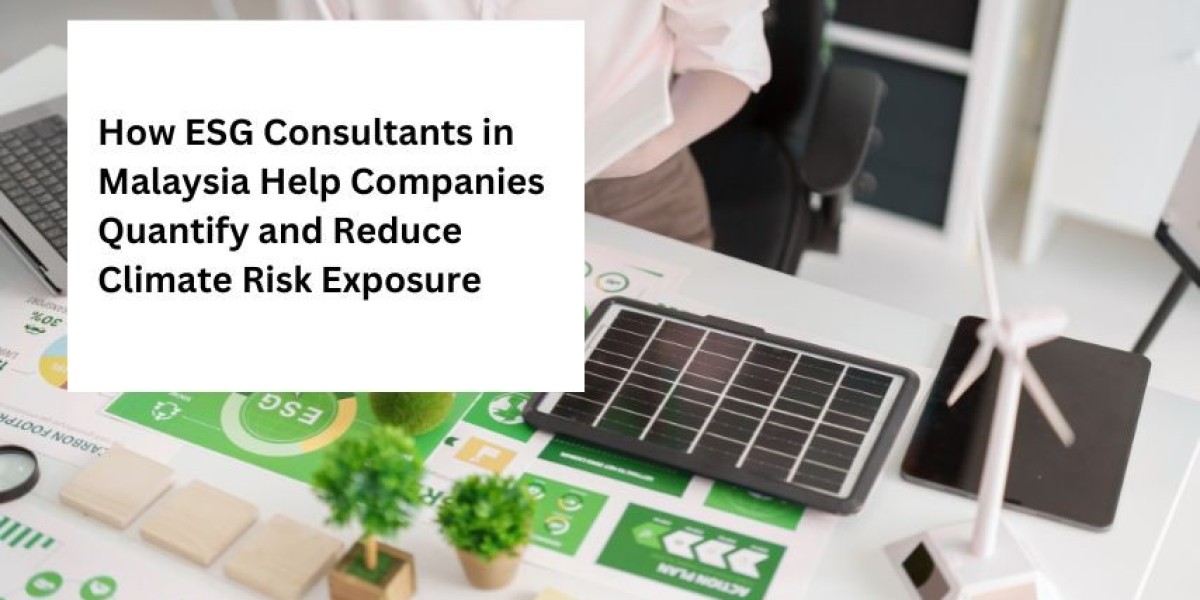Climate change is no longer a distant threat; it is a present reality impacting businesses across Malaysia. From supply chain disruptions caused by extreme weather to shifting consumer preferences and stricter regulations, companies face a complex web of climate-related risks. Navigating this landscape requires more than just good intentions. It demands a strategic, data-driven approach to identify, measure, and mitigate these exposures. This is where ESG consultants in Malaysia provide critical value, acting as strategic partners to help businesses build resilience and unlock new opportunities.
This article will explore the essential role of ESG consultants in helping Malaysian companies manage their climate risk exposure. We will examine the specific strategies and tools they use, highlight key industries that benefit from their expertise, and discuss the growing importance of ESG compliance. Ultimately, you will see how engaging an ESG consultant is not just a cost but a strategic investment in long-term profitability and sustainability.
Understanding Climate Risk: A Two-Sided Coin
Before diving into how consultants help, it is crucial to understand the types of climate risks businesses face. These are generally categorized into two main groups: physical risks and transition risks.
- Physical Risks: These are the direct impacts of climate change on a company's operations, assets, and supply chains.
- Acute Risks: These are event-driven, such as the increasing frequency and intensity of typhoons, floods, and droughts that can damage facilities, disrupt logistics, and halt production. The severe floods that have hit states like Selangor and Pahang in recent years are a stark reminder of these acute physical risks.
- Chronic Risks: These are longer-term shifts in climate patterns. Examples include rising sea levels threatening coastal infrastructure, sustained higher temperatures reducing agricultural yields, and changes in water availability affecting manufacturing processes.
- Transition Risks: These risks arise from the shift toward a lower-carbon economy. As the world transitions, businesses that fail to adapt will face significant challenges.
- Policy and Legal Risks: Governments are introducing new regulations, such as carbon taxes, emissions trading schemes, and stricter environmental standards. Companies could face fines, litigation, and operational constraints if they fail to comply.
- Technology Risks: The development of new, cleaner technologies, like renewable energy and electric vehicles, can disrupt established industries. Companies reliant on older, carbon-intensive technologies may find their products and services becoming obsolete.
- Market Risks: Consumer and investor preferences are changing. There is a growing demand for sustainable products and a shift in capital towards companies with strong ESG performance. Businesses with poor environmental credentials may lose market share and access to funding.
- Reputation Risks: Companies perceived as contributing to climate change or failing to manage their environmental impact can suffer significant reputational damage, impacting customer loyalty and brand value.
The Role of ESG Consultants in Quantifying Climate Risk
You cannot manage what you cannot measure. The first and most critical step in addressing climate risk is quantifying it. A high-impact ESG consultant in Malaysia brings specialized expertise and sophisticated tools to help companies translate abstract climate threats into tangible financial metrics.
Step 1: Climate Risk Identification and Materiality Assessment
An ESG consultant's work begins with a comprehensive assessment to identify which climate risks are most relevant, or "material," to a specific business. This is not a one-size-fits-all process. The risks facing a palm oil plantation are vastly different from those facing a financial institution or a semiconductor manufacturer.
Consultants conduct workshops with key stakeholders, analyze a company's value chain, and review its geographical footprint to map out potential vulnerabilities. They help answer critical questions like:
- Are our key manufacturing plants located in flood-prone areas?
- How would a carbon tax impact our production costs?
- Is our supply chain dependent on water-stressed regions?
- Will changing consumer sentiment affect demand for our products?
Step 2: Scenario Analysis and Climate Modeling
Once material risks are identified, consultants use scenario analysis to model their potential impact under different future climate pathways. This is a powerful tool recommended by frameworks like the Task Force on Climate-related Financial Disclosures (TCFD).
Consultants use established climate models and scenarios, such as those from the Intergovernmental Panel on Climate Change (IPCC), to project potential futures. They might model the financial impact of a 1.5°C, 2°C, or even a 4°C warming scenario on a company's operations. For example, a consultant could help an agricultural company model how different levels of warming might affect crop yields, water availability, and pest prevalence, translating these physical changes into projected revenue losses or increased operational costs.
Step 3: Financial Quantification
The final piece of the puzzle is putting a number on the risk. ESG consultants use advanced financial modeling to quantify the potential costs of inaction. This can include:
- Projected revenue loss from business interruptions.
- Increased operational costs from higher energy prices or water scarcity.
- Asset write-downs for facilities that become stranded or inoperable.
- Potential fines for non-compliance with future climate regulations.
- Increased insurance premiums for assets in high-risk locations.
By expressing climate risk in financial terms, consultants empower boards and management teams to understand the real-world implications and make informed decisions. An abstract risk like "rising sea levels" becomes a concrete financial projection, such as "a potential RM50 million loss in asset value over the next 15 years."
Strategies for Reducing Climate Risk Exposure
After quantifying the risks, ESG consultants work with companies to develop and implement robust strategies for mitigation and adaptation. These strategies are tailored to the company's specific risk profile, industry, and operational realities.
Developing a Decarbonization Roadmap
For transition risks, the primary strategy is decarbonization. An ESG consultant helps a company create a clear, actionable roadmap to reduce its greenhouse gas (GHG) emissions. This involves:
- GHG Accounting: Conducting a thorough inventory of the company's Scope 1 (direct), Scope 2 (indirect from purchased energy), and Scope 3 (all other indirect) emissions. This forms the baseline for setting reduction targets.
- Target Setting: Assisting in setting science-based targets that align with the goals of the Paris Agreement. This demonstrates a credible commitment to decarbonization.
- Identifying Abatement Levers: Pinpointing opportunities to reduce emissions across the value chain. This could include improving energy efficiency, switching to renewable energy sources, redesigning products for lower lifecycle emissions, and engaging with suppliers to reduce their carbon footprint.
Building Climate Resilience Through Adaptation
For physical risks, the focus is on adaptation and building resilience. Consultants help businesses prepare for the unavoidable impacts of climate change. Strategies may include:
- Fortifying Assets: Recommending engineering solutions to protect facilities in high-risk areas, such as building flood defenses or upgrading infrastructure to withstand higher temperatures.
- Diversifying Supply Chains: Identifying and securing alternative suppliers in different geographical regions to reduce dependency on climate-vulnerable areas.
- Developing Emergency Response Plans: Creating robust plans to ensure business continuity during and after extreme weather events.
- Innovating Products and Services: For an agricultural company, this could mean investing in drought-resistant crop varieties or adopting precision irrigation techniques.
Industry Focus: ESG Consulting in Action in Malaysia
The need for climate risk management spans all sectors, but some industries in Malaysia face particularly acute pressures and can derive immense benefits from ESG consulting.
Manufacturing
Malaysia's vital manufacturing sector is highly exposed to both physical and transition risks. Factories are often energy-intensive and can be located in coastal or flood-prone industrial zones. ESG consultants help manufacturers by:
- Conducting site-specific vulnerability assessments for physical risks.
- Identifying energy efficiency opportunities to reduce costs and emissions.
- Developing strategies for sourcing renewable energy through corporate power purchase agreements (PPAs).
- Navigating global supply chain demands for greater transparency on carbon footprints.
Agriculture and Plantations
The agriculture sector, including palm oil and rubber, is on the front lines of climate change. Yields are directly impacted by temperature, rainfall patterns, and extreme weather. ESG consultants assist by:
- Modeling the long-term impact of climate change on crop suitability and yields.
- Recommending sustainable agricultural practices that enhance soil health and water retention, building resilience to drought.
- Helping companies meet international certification standards (like RSPO for palm oil) that require robust environmental management and reporting.
Finance
Financial institutions do not face significant direct physical risks, but they are heavily exposed through their lending and investment portfolios. A bank that lends to companies in carbon-intensive sectors or in high-risk geographical areas is taking on significant indirect climate risk. ESG consultants help banks, asset managers, and insurers by:
- Integrating climate risk into their credit risk assessment and investment analysis frameworks.
- Conducting portfolio-level climate scenario analysis to identify concentrated risks.
- Developing sustainable finance products, such as green bonds and sustainability-linked loans, to help finance the transition to a low-carbon economy.
The Malaysian Regulatory Landscape and Global Alignment
The push for ESG and climate risk management in Malaysia is not just a global trend; it is increasingly embedded in the national regulatory and policy framework. ESG consultants are crucial for helping companies navigate this evolving landscape.
Bursa Malaysia has been a key driver, with its enhanced sustainability reporting requirements for public-listed companies. These rules mandate more detailed disclosures on governance, risks, and opportunities related to sustainability, including climate change. The framework is aligned with global standards like the TCFD, signaling a clear direction of travel.
Furthermore, Malaysia's commitment to becoming a carbon-neutral nation by 2050, as outlined in the 12th Malaysia Plan, will translate into more concrete policies, such as carbon pricing mechanisms and stricter emissions standards. Companies that are not prepared will face significant transition risks. ESG consultants help businesses stay ahead of these regulatory changes, ensuring compliance and turning potential regulatory burdens into strategic advantages.
The Tangible Benefits of Engaging an ESG Consultant
Investing in ESG consulting for climate risk management delivers benefits that extend far beyond compliance and risk mitigation.
1. Improved Risk Management: The most direct benefit is a deeper, data-driven understanding of climate risks, enabling more effective and strategic decision-making.
2. Enhanced Reputation and Brand Value: Proactively managing climate impact and transparently reporting on performance builds trust with customers, employees, and the community.
3. Increased Access to Capital: Investors and lenders are increasingly using ESG data to screen investments. Strong ESG performance, particularly on climate, can unlock access to a larger pool of capital at potentially more favorable terms.
4. Operational Efficiency and Cost Savings: Decarbonization strategies often involve improving energy and resource efficiency, which leads directly to lower operational costs.
5. Long-Term Profitability and Resilience: By anticipating and adapting to climate-related challenges, companies can protect their assets, secure their supply chains, and position themselves for sustained growth in a changing world.
A Strategic Imperative for a Sustainable Future
The challenges posed by climate change are immense, but they are not insurmountable. For companies in Malaysia, the path to resilience and long-term success requires a proactive and strategic approach to managing climate risk. Waiting for regulations to force action or for a climate-related disaster to strike is a high-risk strategy.
ESG consultants provide the expertise, tools, and strategic guidance needed to navigate this complex terrain. They help transform climate risk from an overwhelming threat into a manageable business issue, uncovering opportunities for innovation, efficiency, and growth along the way.
Consider engaging an ESG consultant not as a compliance cost, but as a strategic investment in the future of your business. By quantifying and reducing your climate risk exposure today, you are building a more resilient, reputable, and profitable company for tomorrow.






